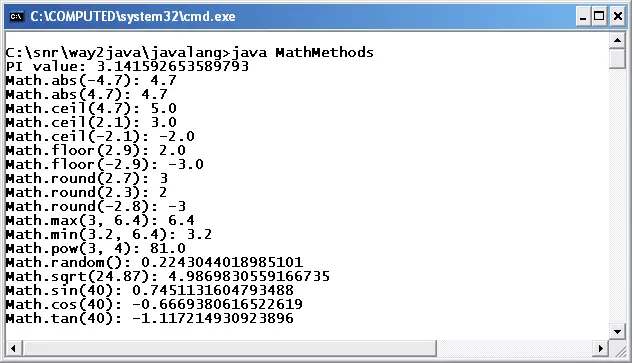Introduction
The java.lang.Math class includes many methods with which many simple arithmetic operations can be done like finding the square root, rounding, trigonometric and logarithm functions. As these methods are defined as static, they can be used directly by the programmer without the trouble of creating an object. Following is the class signature as defined in the java.lang package.
As the class is final, it cannot be extended (like String class, you know earlier).
The Math class includes only two constants as defined hereunder.
public static final double E = 2.7182818284590452354; (Base of natural logarithms)
public static final double PI = 3.14159265358979323846; (ratio of circumference to the diameter of a circle)
Following table gives some important static methods of "class Math Java" and their purpose.
| Method | Legal Parameters | What For |
|---|---|---|
| abs(x) | int, long, float, double | Gives the absolute value of x |
| acos(x) | double | Gives the arccosine of x |
| exp(x) | double | Gives the exponential value to the power of x |
| ceil(x) | double | Gives the minimum value but greater than x |
| floor(x) | double | Gives the maximum value but less than x |
| log(x) | double | Gives the natural log value of x |
| max(x,y) | int, long, float, double | Gives the maximum of x and y |
| min(x,y) | int, long, float, double | Gives the minimum of x and y |
| pow(x,y) | double | Gives a value x raised to y |
| random() | — | Gives a random number between 0.0 to 1.0 |
| rint(x) | double | Gives a double value nearer to x |
| round(x) | float, double | Gives the nearer integer to x |
| sqrt(x) | double | Gives the square root of x |
Note: Also available asin(x), atan(x), sin(x), cos(x) and tan(x) etc. The parameter of trigonometric functions is in radians.
The next program uses some methods of Math class.
public class MathMethods
{
public static void main(String args[])
{
System.out.println("PI value: " + Math.PI);
// abs() method gives a positive value
System.out.println("Math.abs(-4.7): " + Math.abs(-4.7));
System.out.println("Math.abs(4.7): " + Math.abs(4.7));
// rounds to a nearest higher value
System.out.println("Math.ceil(4.7): " + Math.ceil(4.7));
System.out.println("Math.ceil(2.1): " + Math.ceil(2.1));
System.out.println("Math.ceil(-2.1): " + Math.ceil(-2.1));
System.out.println("Math.floor(2.9): " + Math.floor(2.9));
System.out.println("Math.floor(-2.9): " + Math.floor(-2.9));
// rounds as we do in maths; >= 0.5 rounds to higher value else to the lower
System.out.println("Math.round(2.7): " + Math.round(2.7));
System.out.println("Math.round(2.3): " + Math.round(2.3));
System.out.println("Math.round(-2.8): " + Math.round(-2.8));
// gives maximum of the two
System.out.println("Math.max(3, 6.4): " + Math.max(3, 6.4));
// gives minimum of the two
System.out.println("Math.min(3.2, 6.4): " + Math.min(3.2, 6.4));
// gives the power value, first value raised by second value
System.out.println("Math.pow(3, 4): " + Math.pow(3, 4));
// gives a rondom number
System.out.println("Math.random(): " + Math.random());
// returns the square root
System.out.println("Math.sqrt(24.87): " + Math.sqrt(24.87));
// gives trigonometric value (parameter in radians)
System.out.println("Math.sin(40): " + Math.sin(40));
System.out.println("Math.cos(40): " + Math.cos(40));
System.out.println("Math.tan(40): " + Math.tan(40));
}
}

Output screenshot on class Math Java
random() method generates random number. For more on random number generation refer java.util package.